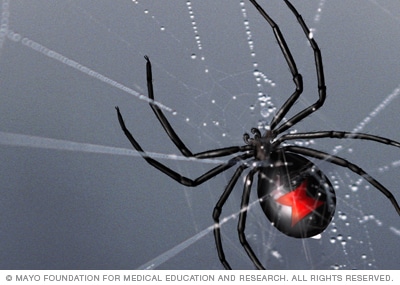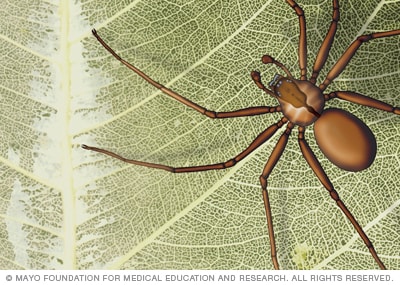
Spider bites: First aid
Most spider bites cause only minor injury. Bites from a few spider species can be dangerous.
Seek medical care immediately if:
- You were bitten by a dangerous spider, such as a black widow or a brown recluse
- You’re unsure whether the bite was from a dangerous spider
- You have severe pain, abdominal cramping or a growing wound at the bite site
- You’re having problems breathing or swallowing
- The area of the sore has spreading redness or red streaks.
To take care of a spider bite:
- Clean the wound with mild soap and water. Then apply an antibiotic ointment three times a day to help prevent infection.
- Apply a cool compress over the bite for 15 minutes each hour. Use a clean cloth dampened with water or filled with ice. This helps reduce pain and swelling.
- If possible, elevate the affected area.
- Take an over-the-counter pain reliever as needed.
- If the wound is itchy, an antihistamine, such as diphenhydramine (Benadryl) or certirizine (Zyrtec) might help.
For pain and muscle spasms, your doctor might prescribe pain medicine, muscle relaxants or both. You might also need a tetanus shot.
Black widow spiders
Black widow spider
Black widow spider

Black widow spider
The black widow spider is known for the red hourglass marking on its belly.
You can usually identify a black widow spider by the red hourglass marking on its belly. In the United States, this spider is more common in the South. It’s also found in Europe.
Signs and symptoms of a black widow spider bite can include:
- Redness, pain and swelling
- Severe abdominal rigidity or cramping
- Nausea, vomiting, tremors or sweating
Brown recluse spider
Brown recluse spider
Brown recluse spider

Brown recluse spider
The brown recluse spider is known for the violin-shaped marking on its top.
The brown recluse spider has a violin-shaped marking on its back, but this mark can be hard to see. This spider is commonly found in the southern half of the United States and in South America, where it is known as the brown spider.
Signs and symptoms of a brown recluse spider bite can include:
- At first, a mild pain
- Fever, chills and body aches
- A deep blue or purple area around the bite, which may develop a red ring around it
.
Stay connected with us on social media platform for instant update click here to join our Twitter, & Facebook
We are now on Telegram. Click here to join our channel (@TechiUpdate) and stay updated with the latest Technology headlines.
For all the latest Health News Click Here
For the latest news and updates, follow us on Google News.

